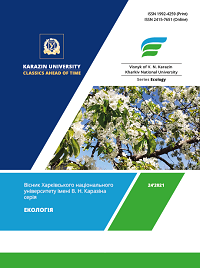Сучасна ландшафтно-технічна структура території міста Вінниці
Анотація
Місто Вінниця представлене селитебною ландшафтно-технічною полісистемою, де виділено дві ландшафтно-технічних урбосистеми: власне селитебна на хвилястих лесових височинах, що розчленовані балками і ярами, з дубово-грабовими лісами у минулому на сірих і світло-сірих лісових ґрунтах; промислово-селитебна на хвилястому лесовому плато з дубово-грабовими лісами у минулому на сірих лісових ґрунтах і чорноземах опідзолених. У структурі цих урбосистем виділено заплавні водно-рекреаційні, схилову лісогосподарську, вододільно-дорожню та вододільно-польову ландшафтно-антропогенні мезосистеми, вододільні малоповерхової житлової забудови, схилові малоповерхової житлової забудови, надзаплавно-терасові малоповерхової житлової забудови, надзаплавно-терасову середньо-багатоповерхової житлової забудови, надзаплавно-терасову промислово-житлової забудови, схилову промислово-складської забудови, вододільну промислово-складської забудови ландшафтно-технічні мезосистеми, руслово-гідроенергетичну, заплавно-ставкові рибогосподарські та заплавну водно-рекреаційну ландшафтно-інженерні мезосистеми.
У структурі сучасних ландшафтів Вінниці за площами переважають ландшафтно-технічні мезосистеми, найменші площі займають ландшафтно-інженерні мезосистеми. Домінують за площами ландшафтно-технічні мезосистеми малоповерхової житлової забудови і в структурі ландшафтно-технічних мезосистем. Для поліпшення стану міського середовища необхідно збільшити частку ландшафтно-антропогенних систем зелених насаджень, особливо навколо річок, доріг та промислових підприємств.
##submission.downloads##
Опубліковано
Номер
Розділ
Ліцензія
Авторське право (c) 2021 Яцентюк Ю. В.,

Ця робота ліцензується відповідно до Creative Commons Attribution 4.0 International License.
Автори, які публікуються у цьому журналі, погоджуються з наступними умовами:
- Автори залишають за собою право на авторство своєї роботи та передають журналу право першої публікації цієї роботи на умовах ліцензії Creative Commons Attribution License 4.0 International (CC BY 4.0), котра дозволяє іншим особам вільно розповсюджувати опубліковану роботу з обов'язковим посиланням на авторів оригінальної роботи та першу публікацію роботи у цьому журналі.
- Автори мають право укладати самостійні додаткові угоди щодо неексклюзивного розповсюдження роботи у тому вигляді, в якому вона була опублікована цим журналом (наприклад, розміщувати роботу в електронному сховищі установи або публікувати у складі монографії), за умови збереження посилання на першу публікацію роботи у цьому журналі.
- Політика журналу дозволяє і заохочує розміщення авторами в мережі Інтернет (наприклад, у сховищах установ або на особистих веб-сайтах) рукопису роботи, як до подання цього рукопису до редакції, так і під час його редакційного опрацювання, оскільки це сприяє виникненню продуктивної наукової дискусії та позитивно позначається на оперативності та динаміці цитування опублікованої роботи (див. The Effect of Open Access).

